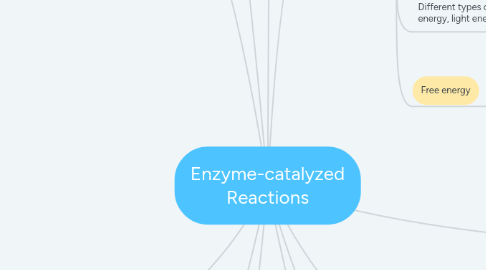
1. Feedback inhibition
1.1. involves use of reaction product to regulate its own further production
1.2. Cell responds to an abundance of products by slowing down production during anabolic or catabolic reactions
2. Enzymes in Reactions
2.1. Each reaction step is regulated or catalyzed by a protein called an enzyme
2.2. Preform the task of lowering activation energy for chemical reactions inside a cell
2.2.1. Do not change the free energy of the reaction
2.3. Without these enzymes to speed up reactions, life would not persist
2.3.1. binding the reactant molecules and holding them to make the bond-breaking easier
2.3.2. Enzymes do not change if exergonic or endergonic
2.4. Substrates
2.4.1. Single reactant substrate is broken down into several products
2.4.2. two substrates may come together to become one large molecule
2.4.2.1. two reactants might enter a reaction and both modify and leave the reaction as two products
2.4.3. The location where the substrate binds is called the enzymes active site
2.4.4. Active sites
2.4.4.1. Subject to influences
2.4.4.1.1. Temperature increases reaction rates
2.4.4.1.2. hot temperatures will cause enzymes to denature
2.4.4.2. Inhibitor molecules
2.4.4.2.1. Competitive inhibition
2.4.4.2.2. Non-competitive inhibition
2.4.4.2.3. Allosteric inhibition
2.4.5. Induced fit substrate binding
2.4.5.1. As the enzyme and substrate come together their interaction causes shift in structure of enzyme that forms a more ideal binding arrangement between enzyme and substrate.
3. Thermodynamics
3.1. 1st law: total amount of energy in the universe is constant and conserved
3.1.1. Energy can be transferred from place to place or converted to different forms
3.1.2. cannot be created or destroyed
3.1.3. Ex: Light bulbs use electricity to create resistance that emits light
3.2. 2nd law: all energy transfers involve the loss of some amount of energy in an unusable form such as heat
4. Heat Energy
4.1. Defined as the energy transferred from one system to another that is not work
4.2. High entropy means high disorder and low energy
5. Exergonic Reactions
5.1. spontaneous
5.1.1. less stored energy than the reactants
5.1.1.1. immidiate
5.2. Ex. Rusting of iron is spontaneous that occurs slowly
5.3. Requirement of a SMALL amount of energy
6. Energy
6.1. Potential
6.1.1. Kinetic
6.1.1.1. Energy in motion
6.1.2. Stored energy
6.2. Nutrients and other molecules are imported into the cell--Providing energy
6.3. Thermodynamics: study of energy and energy transfer involving physical matter
6.4. Open system: energy that can be exchanged with it's surroundings
6.4.1. Closed system: cannot exchange energy with it's surroundings
6.4.2. Organisms are open systems--Energy is exchanged between itself and it's surroundings
6.5. The ability to do work or create change
6.6. Different types of energy include heat energy, light energy, and electrical energy
6.7. Free energy
6.7.1. Quantifying energy transfers
6.7.2. 2nd law of thermodynamics
6.7.3. Energy associated with a chemical reaction that is available after the losses are accounted for
6.7.3.1. unusable-energy available to do work
7. Bioenergetics
7.1. Concept of energy flow through cells
7.2. Building and breaking down complex molecules occurs through chemical reactions
7.2.1. Some spontaneous and release the flow of energy
7.2.2. Some reactions require energy (don't have it already)
7.3. Organisms must have a continuous source of food to replenish supply in energy
8. Metabolic Pathways
8.1. Example: Sugar is used to produce energy (chemical reaction)
8.1.1. Sugar molecules have a large quantity of energy within their bonds, during photosynthesis, plants produce these bonds.
8.1.2. Plants use sunlight energy and convert carbon dioxide gas into sugar molecules
8.1.2.1. Oxygen is their waste product
8.1.2.2. 6CO2 + 6H2O–>C6H12O6 + 6O2
8.1.2.2.1. Synthesizing energy-storing molecules require energy input.
8.2. Light reactions (photosynthesis) energy is produced by a molecule called adenosine triphosphate
8.3. A series of chemical reactions that modifies a starting molecule through steps in a series and intermediates ending with a final product
8.4. Anabolic pathways
8.4.1. Building polymers
8.5. Catabolic pathways
8.5.1. Breaking down polymers into monomers
8.6. ATP-primary energy source of all cells
8.6.1. C6H12O6 + 6O2–>6H2O + 6CO2
8.6.2. Reverse reaction of phtosynthesis
8.6.2.1. Carbon dioxide is released as a waste product
8.6.3. Build complex molecules
8.6.4. Transporting materials
8.6.5. powering the motion of cilia or flagella
8.6.6. contracting muscle fibers
8.7. Cell metabolism
8.7.1. The chemical reactions that take place within the cells
9. Catabolic pathways
9.1. Generation of energy by breaking down larger molecules
9.2. Requires to maintaining cell energy
10. Anabolic pathways
10.1. Require energy to synthesize larger molecules
11. Endergonic Reactions
11.1. Absorption of energy
11.1.1. ∆G for the reaction will be positive

